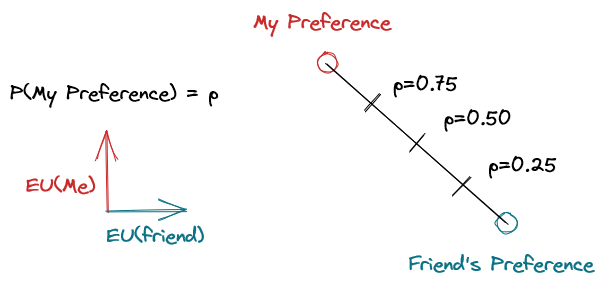Do uncertainty/planning costs make convex hulls unrealistic?
post by eapi (edward-pierzchalski) · 2022-10-06T00:10:32.325Z · LW · GW · 4 commentsThis is a question post.
Contents
Three stories None Answers 3 Dagon None 4 comments
It's almost a rule that as soon as you have a "utility of possible outcomes" plot like this:

You must then say "and by randomly choosing between the outcomes, we can achieve any intermediate outcome in terms of utility within the convex hull of these points" resulting in a plot like this:

Cool, I've done a linear interpolation before, seems reasonable. Plus, convex hulls are super nice to work with. But all models are imperfect - how accurate is this convex hull idea in practice?
Three stories
- I like to plan ahead, whereas my friend values chaos and unpredictability. When we want to go to a restaurant, they're a big fan of the whole "lottery between your first preference and my first preference" idea.
- If we're meeting at 7PM and the lottery happens at 7AM that's long enough to plan, so I don't mind.
- If we're meeting at 7PM and the lottery happens at 6:59PM, I am a little annoyed - I might even prefer my guaranteed second preference over my uncertain first preference.
- The "standard model" for what the outcome space looks like before picking is something like this:

- I'm a CEO managing a business undergoing a possible merger. The more uncertain the deal is, the more all of my projects are disrupted. I might be fine walking into the final meeting with a 99% or 1% chance of success, but I would be quite stressed if the numbers were 90% or 10%.
- I'm a computer, beep boop. I've been modelling deterministic systems all day long. Someone has just asked me to model something probabilistic, and now I need to learn around 70 years of research to not be overwhelmed by the state space explosion.
My point is that in practice the mapping from lottery probability and outcome utilities to lottery utility is probably not . I wonder if it's occasionally not even close. I would expect the "lottery closure" of the three outcomes above to look something like this:

I'm pretty darn sure I'm not the first person to think about this, so: how big an issue is this when thinking about things like bargaining solutions, or stochastic Nash equilibria?
Answers
Yup, you need more dimensions to include utility of certainty at a time, utility of impact on future games, emotional cost of negotiation, and other factors that aren't mentioned in your simplistic 2D payout matrix. And each player's utility function is the projection of this many-dimensional space onto a line for that decision. Your simpler fix is insufficient - the uncertainty cost is not necessarily smooth, and is not the only factor missing.
This more complete modeling, in theory, will just make sure the points are in the right place on your 2-d projection, and you still get a convex hull over them. Most classes teaching this will mention that the utility is "all inclusive", but don't spend much time on defining that, or noting how weak it makes the theory. Note that the costs of uncertainty can vary with the probability distribution, so you can't necessarily pick anything in between without re-projecting the points (or treating each distribution as a new projection, and you can only pick actual intersecting points).
In practice, humans don't have a utility function, don't know how to introspect what preferences they do have, and have inconsistencies that make this fail for almost all real decisions.
↑ comment by eapi (edward-pierzchalski) · 2022-10-07T00:14:21.101Z · LW(p) · GW(p)
I agree my "fix" is insufficient - in fact I'd go so far as agreeing with JBlack below that including it was net negative to the question.
I'd like to pin down what you mean by your description of a more complete model, I hope you don't mind.
Let me flesh out the restaurant story. The actors are (me) and (my friend). The restaurants are and . There are two events we care about: the first is me and my friend choosing the lottery parameter , and the second is actually running the lottery.
After picking but before the lottery, my friend and I have (for simplicity) fixed costs and outcome-dependent utilities and . Our expected utilities are indeed exactly what you'd expect: . Is this what you mean by eventually projecting to a straight line?
The "standard model"/convex hull isn't describing the space of outcomes of the lottery, it's describing the space of lotteries by summarizing them as expected utilities. However, as varies can draw any number of weird and wonderful (and as you say, sharp and discontinuous) shapes. Once we fix and hence , we get a specific shape/space of (expected) lottery outcomes. Is this what you mean by having the utility function be "all inclusive"?
Now that we've got a nice, fixed set of outcomes with an associated utility per outcome, we can take a hyperprior over to get a distribution over that space of outcomes, and we're back in standard-utility-theory land.
I think I've identified my confusion: we should distinguish between the distribution choice parameterized by , and the prior distribution over expected outcomes which we can get with a distribution over . If we were playing a game where we made a choice about that distribution over , we'd have the same problem: our utilities could depend on the prior and so the outcome space would again be an arbitrary shape.
So, summary: it's invalid, as a design choice when formulating e.g. a bargaining solution or a game equilibrium, to do the following:
- Start from a space of outcomes.
- Say "and now the players choose a distribution over the outcomes".
- Conclude "our new space of outcomes is the convex hull of the old space of outcomes".
Does that sound right?
4 comments
Comments sorted by top scores.
comment by JBlack · 2022-10-06T04:26:04.328Z · LW(p) · GW(p)
One catch is that in the examples, the state spaces being compared aren't probability mixtures at all.
In the 6.59pm restaurant lottery example, the outcomes at 7pm are not just "you eat at restaurant X" for two possible values of X. They also include "you had to use extra resources to cover both contingencies", "your mood was affected by the late decision" and possibly even "your friend's option was drawn but was too far away for you to get to by 7pm so you had to go home and eat microwaved ramen instead".
That is, none of these outcomes are the same as any of the outcomes from a 7am lottery (or a nonrandom restaurant choice), and it doesn't matter what cost function you assign to entropy of the distribution. There are real physical differences that mean that the utilities will generally be different.
Sometimes utility may even be higher for the more uncertain outcomes. For example some people value anticipation and revelation of potential gifts more than receiving the same gift with knowledge in advance of what it will be.
Replies from: edward-pierzchalski↑ comment by eapi (edward-pierzchalski) · 2022-10-06T10:33:16.209Z · LW(p) · GW(p)
Hmm, I'm not sure what I should be taking away from that. You've pointed out that the morning and evening lotteries are materially different, but that's not contentious to me: if uncertainty has costs then those costs have to show up as differences in the world compared to a world without that uncertainty.
I guess the restaurant story failed to focus on the-bit-that's-weird-to-me, which is that if my friend and I were negotiating over the lottery parameter , then my mental model of the expected utility boundary as varies is not a straight line.
To be explicit, the "standard model" of my friend and I having a lottery looks like this, whereas once you account for the costs of increasing uncertainty when is away from or it ends up looking like this.
Replies from: JBlack↑ comment by JBlack · 2022-10-06T22:59:49.558Z · LW(p) · GW(p)
Yes, I'm not contending against your fundamental point. In fact, I think that the curve from 0 to 1 can be even stranger than that with discontinuities in it, and that under some circumstances it can even have parts that go above the straight line. Focusing on a specific formula based on entropy doesn't really match reality and detracts from the main point.
Replies from: edward-pierzchalski↑ comment by eapi (edward-pierzchalski) · 2022-10-06T23:15:18.328Z · LW(p) · GW(p)
Fair point re. focusing on a specific formula, I'll remove that from the post.